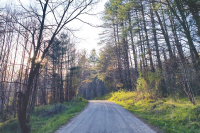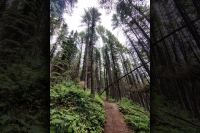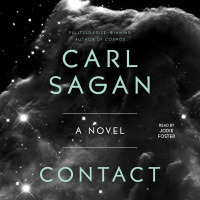From Here: Authors spotlight Haywood County
In an expanding spotlight of regional and national acclaim, three of Western North Carolina’s own have distinguished themselves by penning novels that have shed new literary light on our region. In what must be an unprecedented literary flourish of recent novels all set in the environs of a single western county, Charles Frazier, Ron Rash and Wayne Caldwell have, as the saying goes, “done Haywood County proud.”
Multiple literary award winners all, Frazier, Rash and Caldwell have put place at the center of their fiction writing and have brought national attention to these mountains in such a way not seen since the first half of the 20th century when Thomas Wolfe, a native son of Asheville, took the United States by storm with his brilliant novel, Look Homeward, Angel.
The old post-Civil War adage of “the South shall rise again” has, at the turn of this new millennium, proven to be something of a twice-told tale in the mountains of Western North Carolina. In their novels Cold Mountain (Frazier), Serena (Rash) and Cataloochee (Caldwell), these writers have brought not only accolades and high praise, but world-class fiction to our doorsteps and into our homes here in Haywood and Jackson counties. And what is maybe most remarkable is that in writing about this place, all three are “from here.” Not outsiders who have moved to these mountains from somewhere else, as is usually the scenario concerning literary success and subject matter, but all three of these writers have family roots deep in Western North Carolina soil. In that sense we can all be proud and can truly say that these are “local boys who have made good.”
While, individually, each one of these authors and their books are wonderfully unique, they do all share some common ground. All three of these stories are set in rural landscapes, and in fact are centered, specifically, in Haywood County. All three have to do with the theme of outsiders coming into the mountains and bringing with them the destruction of both place and culture, and in this sense are more epic tellings of the “Beauty and the Beast” story. All three are tragedies in their own way. And all three draw on longstanding classic literary traditions and authors to tell their respective tales.
In the case of Cold Mountain, Frazier’s “beast” is the Civil War and primarily the “northern invaders” who have wreaked havoc upon the hinterlands and homesteads of these hills. In Serena, Rash’s beast is manifested in the large timber companies from the North that have come into the mountains to claim, consolidate and clearcut the land and lives of their inhabitants. And in Caldwell’s wide-sweeping and to-be-extended epic Cataloochee, we are early in the book introduced to the “iron beast” of the railroad, which is symbolic for what is to come and what that “beast” will bring into Western North Carolina from the outside in the form of the federal government and the National Park system, which will, ultimately, uproot and displace hundreds of local families and communities.
As to literary lineage and classics we can connect and compare them to, each of our three authors comes from good stock. In Cold Mountain, Frazier has taken Homer’s Odyssey and re-set it in 19th century Western North Carolina to tell his tale of an epic journey. Rash has gone to the shelves of Shakespeare and found a copy of Macbeth and has written his tale in the genre of tragic drama. And Caldwell has chosen to emulate none other than Tolstoy with his wide sweep of history and characters, his train, and the over-riding theme of social inequities and defense of the local peasantry. All three writers see the local through the same lens as did Homer, Shakespeare and Tolstoy.
In general, we can say of these local-boys-made-good that each of them is a major writer with major New York publishers (Atlantic Monthly, HarperCollins and Random House), and each has written a best-selling book on the world stage. These writers know their fictional characters intimately from the inside out, having heard the essences of their stories from family members, passed down through the generations — all three coming from strong oral history backgrounds and cultures here in the mountains. As I said, and I can’t emphasize this enough: they are from here.
Serena is the most recent of the three books placed in Haywood County to appear on the radar screens of local readers, having been published this fall, while Cataloochee was first released in 2007 and Cold Mountain came out in 1997 (which doesn’t seem that long ago). I can remember talking with Ron Rash after a reading he gave at City Lights Bookstore in Sylva about a year and a half ago — when he was still writing Serena — and asking him where he’d gotten the seed idea for the novel from which he had just read a section to a full house.
“It was when I was up at the Highlands Biological Center in Highlands giving a talk a year or so ago, and I had noticed a cross-section of a large chestnut tree that had been varnished and was on display there. This tree, I was told, had been cut during the big timber boom in the first half of the last century. This made an impression on me, and I immediately began doing some research and reading about the logging industry here in Western North Carolina in order to learn more about it.
“It wasn’t long after that, I was driving through Haywood County in the neighborhood of where my novel would eventually take place, and I had a vision of this woman on a white horse up along a nearby ridgeline. This experience was profound and almost immediately I knew that the woman on the white horse was the central character for my book on the logging industry here in the mountains during the Great Depression.”
Unlike any of his previous three novels, all set in the Southern Appalachian region and borrowing from more traditional Southern writing styles, Serena takes a huge about-face and moves more in the direction of a book parented by the unlikely union of Cormac McCarthy and Gabriel Garcia Marquez. In a tale as dark and unforgiving as anything McCarthy has entrusted to paper (with the possible exception of his recent post-apocalyptic novel The Road), Rash, in a style which is as much film script and libretto as literary prose, tells the story of an unsympathetic heroine (who is not from here), a “Lady Macbeth,” whose ambition for wealth and power cuts a large swath of death and destruction through the western North Carolina landscape. In telling this tragic tale, Rash draws not only from some great characters and scenes from Shakespeare’s plays, but from his earlier life where he had earned a regional reputation as a poet. The metaphors and similes are literally oozing from Serena’s pages:
He drank again and finished off the bottle. He sat in one of the Coxwell chairs and closed his eyes, waited for the whiskey to take hold. Pemberton hoped the half-quart was enough and tried to help it along. He imagined the thoughts seeking connection in his head were like dozens of wires plugged into a switch-board, wires the whiskey would begin pulling free until not a single connection was possible.
In a few minutes, Pemberton felt the alcohol expanding in his skull, the wires pulling free, one at a time, the chatter lessening until there was no chatter at all, just a glowing hum. He closed his eyes and let himself sink deeper into the chair.
Along with the clinically cold Lady Macbeth-like heroine of Serena, Rash juxtaposes his haunting story against lighter scenes reminiscent of Shakespeare’s servants and shepherds, rogues and ruffians, fools and heralds meant to entertain the locals in the pit of the old theaters. In Serena these scenes are played by members of a logging crew up along the ridges of Cove Creek that is overseen by a man we only know as Snipes, who is a kind of Appalachian Falstaff. Instead of the streets and taverns of London, Rash’s scenes take place in a steep slash-and-burn landscape on Shanty Mountain. We are entertained by exchanges of Appalachian Mountain dialect and wit that Rash surely must have heard from his kith and kin growing up. They are as real and as true to form as anything I heard growing up over in Graham County in the 1950s. These plot-line “asides” by Rash’s band of brigands — Snipes, Ross, Henryson and McIntyre — lend a much-needed levity to an otherwise relentlessly dark tale. Likewise, Rash’s injections of haute language (les mots etranger), a la Christopher Camuto’s Another Country, not only raises the bar in terms of the quality of the writing but lends a bit of spice to the overall taste of the work. Here, Snipes is talking about McIntyre from Chapter 19 in the book:
“Maybe that’s what’s wrong with Preacher McIntyre,” he said. “He growed up in the most way-back holler in this country. He told me once it was so darksome in there they had to use a crowbar to get any light in.”
Similar to Rash’s “creation myth” for Serena, I recall Charles Frazier telling me one evening in the Captain’s Bookshelf in Asheville that his second novel, 13 Moons, set over in Swain and Jackson counties and published in 2006, came from a supposedly true story he had heard about Will Thomas. (The model for the book’s central character of Will Cooper is the historically real person of Will Thomas, who was once-upon-a-time Chief of the Cherokee Eastern Band). They say Will Thomas used to sit on his front porch over near Whittier and take pot-shots at tourists as they rode by on the train. (The symbolic train motif, again.) Similarly, Frazier had fashioned Cold Mountain from stories and pictures envisioned from tales he had heard from or about members of his own family and distant relations. While not quite the dark “runaway train” that is Rash’s Serena, Frazier’s Cold Mountain, placed in a setting at the end of the Civil War, is also full of shadowy characters and harsh realities taken from the pages of bygone days here in the Smoky Mountains of the Blue Ridge. Yet Frazier’s American brand of magic realism is couched in a cushion of poetic lyricism that gives the book a more fluid feeling than Rash’s staccato and more theatrical style. Both work marvelously, yet in their own uniquely individual ways.
From Cold Mountain:
An owl hooted from the trees beyond the creek. Ada counted off the rhythm of the five-beat phrase as if scanning the lines of poetry: a long, two shorts, two longs. Death bird, people said of the owl, though Ada could see no reason why. The call was so soft and lovely in the slaty light, like a dove’s cry but with more substance to it. Waldo bawled at the gate, impatient, needin — as so much did in the cove — the things Ada was learning to do, so she took her hands from the ground and stood.
Cataloochee, Wayne Caldwell told me recently over dinner in Asheville, is a long historical work, many years in the making and covering a time span of four generations from 1864-1928.
“It’s the historic prelude that led up to the government’s confiscation of land in Madison and Haywood counties — by hook, crook and eminent domain and displacing hundreds of mountain families, including some of my own people,” he said. “This story runs in my blood, I guess you could say. And it’s a part of regional and national history, like the removal of the Native peoples, that has been largely ignored, forgotten, and I felt was begging (me) to be told. The sequel to Cataloochee, which I‘m working on now, will get more into the politics and the actual displacement of mountain people.”
While Caldwell’s Cataloochee is more realism than the magic realism that the other books are built on, and is dominated primarily by a sense of social history, it is really driven by the language, by dialogue and dialect. This is a language Caldwell knows well, being Western North Carolina born and bred. Caldwell’s is a prose that lingers. Lingers through a clearer picture of everyday domestic family life. In this sense, it is more about detail than high drama. A much kinder, gentler Haywood County than is portrayed by his two contemporary literary cohorts. And the Carter/Banks family, which we follow through four generations, speaks to us through a story of human-scale realities and experiences that is almost timeless in its sense of rootedness and place.
If Caldwell hasn’t lived much of what he writes in Cataloochee, then he surely was paying attention to the stories and the speech he grew up around. Such prodigious passages as this one permeate the 349-page book:
Jack Carter was far from dark-minded, but had inherited a streak of what his mother called “worriment,” along with her conviction that while a body ought not hunt for trouble, nonetheless he should be watchful, for woe walks up and down in the world. It was 1928, the first day of October, the time of year yellow jackets turn ill. Nearly ready for winter — apples and beef cattle sold, firewood stacked in the dry — yet weather too warm to kill hogs. The in-between, a time when man thinks he deserves some rest, but woman knows none awaits.
In many ways, the biblical “Garden of Eden” theme runs through each of these three great books. Each one comes at it from a different angle and perspective. In the end, it’s about what has been lost, what has been taken from these mountains. “Blood crying from the ground,” as Caldwell puts it. Reading the books written by these three authors and set in our mountains of Western North Carolina gives one pause, gives one reason to contemplate (“to study” as one of their characters might say) what has been the price of so-called “progress” during the various invasions that have taken place in these hills in the last two centuries. It began with the invasion of the Europeans and the displacement of the Indian peoples, followed by the Civil War (and the invasion of the Union armies) and the invasion of the “Yankee” logging companies coupled with the incorporation of the National Park System in the Smokies in the first half of the 20th century, and continuing on to today with the recent invasion of large developers and their gated communities for second homes. All the while, as Caldwell’s character Preacher Noland says at the end of Cataloochee, “It’s brother against brother and father against son,” as those of us who remain here, with our great writers Frazier, Rash and Caldwell in our midst, work hard to hold on to what little bit of “Eden” still remains.
(Thomas Crowe is a poet and writer who lives in the Tuckasegee community of Jackson County. His latest book is The End of Eden: Writings of an Environmental Activist published this fall by Wind Publications. He can be reached at This email address is being protected from spambots. You need JavaScript enabled to view it..)













